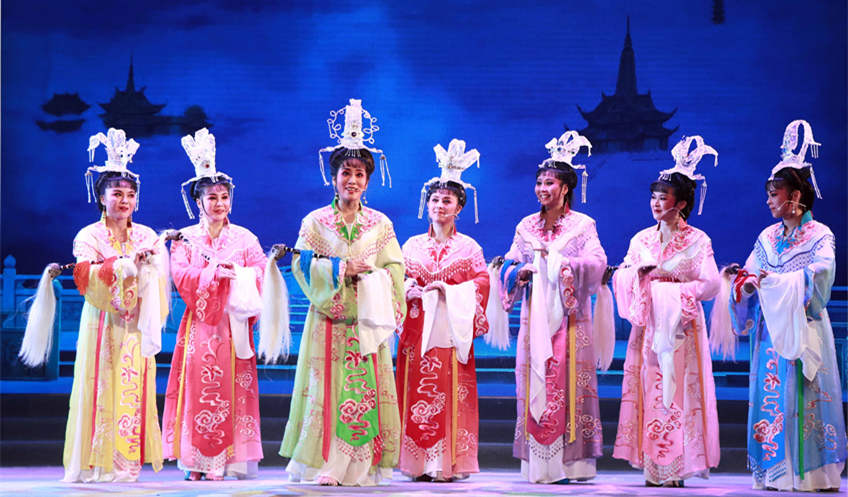Huangmei Opera
Originally called Huangmei Tone or CaiCha Play, Huangmei Opera is a local opera of the Han nationality. Being one of Chinese big five operas, Huangmei Opera enjoy equal popularity with Beijing Opera, Yue Opera, Ping Opera and Yu Opera. It originates from Huangmei, a junction of Hubei, Anhui and Jiangxi. The original form of Huangmei Opera is CaiCha songs in Huangmei area, Hubei Province. With smooth tone and rich expression, Huangmei Opera is read and sung in Anqing language. Thanks to its full-bodied vitality and fresh folk flavor, Huangmei Opera has swiftly grown into a professional performance piece in both rural and urban areas.

Origin
According to historical records, the opera's beginning can be dated back to the Tang Dynasty. The early stage of Huangmei Opera is from Qianlong period in the Qing Dynasty to the Revolution of 1911. Near the end of the 19th century, during the years of Daoguang in Qing Dynasty, Huangmei Opera spread to Anqing, Huaining, Susong, Wangjiang from Huangmei county. That was when Huangmei Opera really began to thrive. It was combined with other folk songs and dances. In Anhui province, some local folk arts were absorbed into Huangmei Opera, such as Yuexi high Melody, Qingyang Melody and Hui Melody. So it had well progress and became characteristic opera.From its origin to its development, Huangmei Opera has experienced monodrama, three playlets, three playing seven singsing and accompanying with orchestral music these four historic stages. The first three stages are completed in Huangmei, Hubei Province. It provided full prerequisites for Huangmei Opera to form a great opera in China. The important historical stage of “three playing seven singing” is from the Qing emperor Kangxi period to emperor Guangxu period. The traditional repertoire, sing tone and performance art accumulation was widely spread in this stage. At that time, most of playlets were based on many true stories and full-scale dramas mostly expressed the people's dissatisfaction for classical oppression and the yearning for a happy free life.
Development
Huangmei Opera is mainly flourishing in Anhui province. Huangmei performance groups can be found not only on the Chinese mainland but also in Hong Kong, Macao, Taiwan, Malaysia, Japan, and even Europe. Originally called Huangmei tone, Huangmei Opera was a form of rural folksong and dance. It was famous for its melodic music, vivid performing style, straightaway language of art, and actual portrayal of life. The name of “Huangmei Opera” was appeared in 1921.The development history of the Huangmei Opera can roughly be divided into three stages. The first stage, begin from Qianlong period in Qing Dynasty to the revolution of 1911. Caicha tone, Jiangxi tone, Tongcheng tone and Fengyang song formed and spread in the junction of Anhui, Hubei, Jiangxi, was influenced by local traditional opera. It combined with some folk art and gradually grew up into some playlets. During the further development, it absorbed performance content from “Luohanzhuang” and “Qingyang tone”. The complete story was finally formed.
The second stage begins from the revolution of 1911 to 1949. The Huangmei Opera performances became gradually professional in this stage. It had gone a long way from its status as a recreational activity to professional performances in big cities.
The Huangmei groups performed together with troupes that specialized in more popular forms of the art, like the Beijing Opera and Anhui Opera. Huangmei Opera managed to reach Anqing in 1926. After entering into Anqing City, Huangmei Opera once shared the same class with Beijing Opera. Influenced by Shanghai`s Yue Opera, Yang Opera and Huai Opera, and the north`s Ping Opera, Huangmei Opera has played great changes in the content and the form of performance. Huangmei Opera appeared in Shanghai in 1934, but only on makeshift stages in the city's poor quarters where it was denounced as "bawdy entertainment" and its unfortunate performers were harried by local authorities.
The third stage begins from 1949 to today. Nowadays, Huangmei Opera has also spread its fame both home and abroad with its sweet melodies and lyrics, graceful sounds and movements, and beautiful costumes and sets. It is mainly popular in Hubei, Jiangxi and Anhui provinces. Its older generation of famous actors and actresses include Yan Fengying, Wang Shaofang and Pan Jingli, and its young artists include Malan and Hanzaifen.
Characteristics
In terms of play program, Huangmei Opera contains the big play and the small play. The big play mainly expresses the people`s dissatisfaction for classical oppression and the yearning for a happy free life. The small play mostly shows some life`s fragments of the rural laborers.
The category of Huangmei Opera consists of two sorts. One is Pingci and the other is Huangqiang. Huangqiang primarily takes playlets as its content. It consists of folk ballads and canzonets, and full of rich life breath and folk flavor. As the leading singing tone in Zhengben Opera, Pingci always uses narrate to express the roles’ emotion. The performing art of Huangmei Opera pays attention to abstracting the distillate of the life.Huangmei Opera costumes contain a distinctive local flavor of China's ancient past. Costumes and sets change according to the opera's social environment and customs since the contents of the opera are often varied. Huangmei Opera music features folk songs that are graceful and sweet-sounding. Coloratura, character songs and basic tunes are three types of music. Since Huangmei Opera music is light and lyrical, a good performer must be skilled in performing such a style. Huangmei Opera is easy to understand and learn thanks to its lyrical tunes, simple words and literary tradition.
More about Chinese Opera: